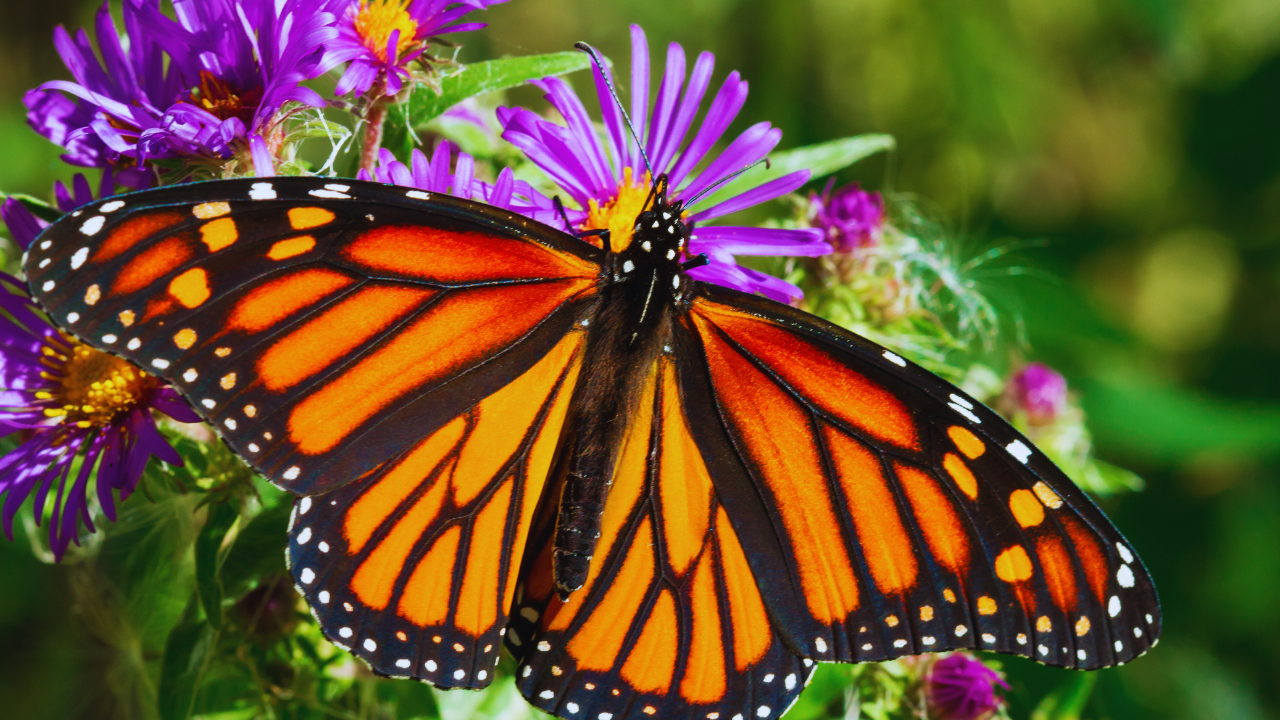The monarch butterfly is one of the most fascinating creatures in this world, owing to their migratory routine. These butterflies are equipped with light and temperature sensors in their brain and a magnetic compass, which facilitates their winter migration, each year, from the US and Canada where they breed to forests in central Mexico for hibernation. The butterflies have an antenna which recognizes the time of the day and the sun’s position in the sky. They fly between 1800 miles to 2,800 miles to find the right climate conditions to hibernate from the beginning of November to mid-March.
Known to scientists as Danaus plexippus, meaning ‘sleepy transformation’, these littles butterflies have a wingspan of 4 inches. Males possess orange wings with black veins, and white spots on the edges. The males are slightly bigger than the females. Monarchs are known to lay their eggs on Milkweed, which is the only source of food for the caterpillars. The milkweed they consume during larval stage is stored in their body, which is poisonous and might cause their predators to vomit, and in rare cases death. The adult butterflies have a life cycle of just 4-5 weeks.
Monarch butterflies are found in Mexico’s oyamel fir forest. Upon arriving these monarchs gather in sheltered sites where they huddle together on trees to hibernate. While researchers have found quite a lot about their migratory patterns, the question that still bothers them all is how these butterflies find the particular oyamel fir trees.
The forests of the migratory monarchs are protected within Monarch Butterfly Biosphere reserve, a UNESCO world heritage site. These butterflies are unfortunately under threat due to extensive use of pesticide and climate change. According to a report, the number of monarch butterflies at their wintering areas have dropped by 59%, the second lowest since records were kept. The butterflies are not counted individually; rather record is kept by measuring the number of hectares they cover when they clump together during hibernation. Mexico’s Commission for National Protected Areas said that this year butterflies covered an area of 0.9 hectares which is much less than the last year when it was 2.21 hectares.
The use of herbicides in the US, ongoing land developments, turning of grasslands into farmlands, reduction of milkweeds are some of the ways through which these little creatures are finding it hard to migrate for hibernation and thus reducing their numbers. While there has been a fluctuation in the numbers of the monarchs, the eastern population has seen a steady decline over the last two decades. Planting the right species of milkweed in certain areas can help the monarchs survive.
Known to scientists as Danaus plexippus, meaning ‘sleepy transformation’, these littles butterflies have a wingspan of 4 inches. Males possess orange wings with black veins, and white spots on the edges. The males are slightly bigger than the females. Monarchs are known to lay their eggs on Milkweed, which is the only source of food for the caterpillars. The milkweed they consume during larval stage is stored in their body, which is poisonous and might cause their predators to vomit, and in rare cases death. The adult butterflies have a life cycle of just 4-5 weeks.
Monarch butterflies are found in Mexico’s oyamel fir forest. Upon arriving these monarchs gather in sheltered sites where they huddle together on trees to hibernate. While researchers have found quite a lot about their migratory patterns, the question that still bothers them all is how these butterflies find the particular oyamel fir trees.
The forests of the migratory monarchs are protected within Monarch Butterfly Biosphere reserve, a UNESCO world heritage site. These butterflies are unfortunately under threat due to extensive use of pesticide and climate change. According to a report, the number of monarch butterflies at their wintering areas have dropped by 59%, the second lowest since records were kept. The butterflies are not counted individually; rather record is kept by measuring the number of hectares they cover when they clump together during hibernation. Mexico’s Commission for National Protected Areas said that this year butterflies covered an area of 0.9 hectares which is much less than the last year when it was 2.21 hectares.
The use of herbicides in the US, ongoing land developments, turning of grasslands into farmlands, reduction of milkweeds are some of the ways through which these little creatures are finding it hard to migrate for hibernation and thus reducing their numbers. While there has been a fluctuation in the numbers of the monarchs, the eastern population has seen a steady decline over the last two decades. Planting the right species of milkweed in certain areas can help the monarchs survive.
end of article

